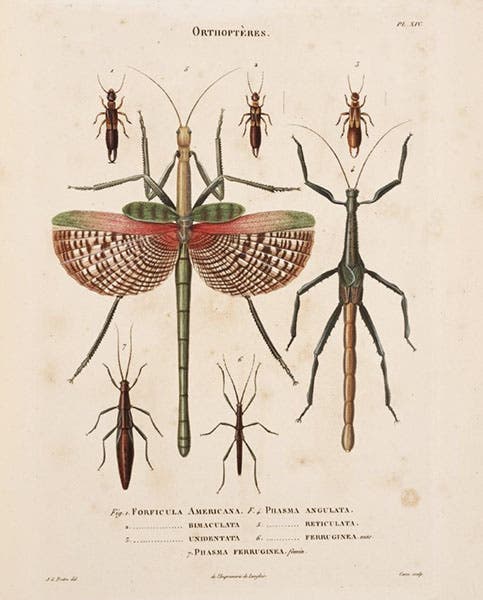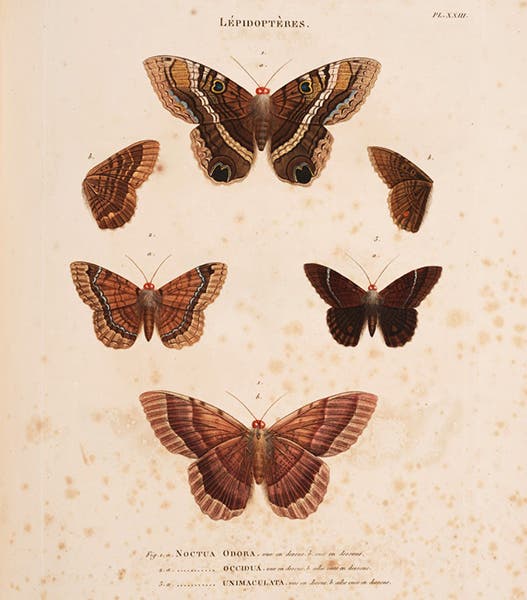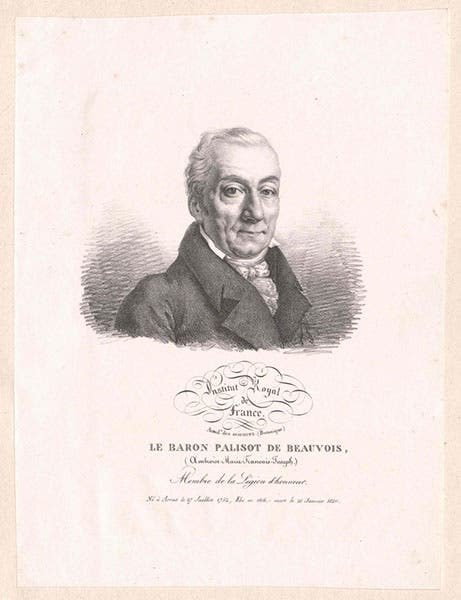Scientist of the Day - Ambroise Palisot de Beauvois
Ambroise-Marie-François-Joseph Palisot, Baron de Beauvois, was born July 27, 1752, in Arras, France. Palisot came from a wealthy family and trained as a lawyer, but he became distracted by natural history, and he would remain distracted for most of his life. He went to Benin in West Africa in 1786, where he collected plants and insects, sending them back to the museum in Paris. When he became quite ill with malaria in 1788, he travelled to Haiti, where he recovered his health, but was caught up in the slave rebellion of 1791, unfortunately on the side of those trying to retain slavery in the colonies. He fled to the United States in 1793, losing all of his possessions and collections enroute, so that he arrived destitute, working at jobs as he could find them. With the help of the French ambassador, he arranged to travel and collect in the young republic, thereby coming to the attention of Charles Willson Peale in Philadelphia; he was then invited to join the Academy of Natural Sciences there. Palisot wanted to go home to Paris, but he had been on the wrong side of that revolution as well, all his land and possessions having been confiscated. By 1798, however, his name and property were restored, and he returned home, where he set about publishing a book on the insects he had collected in Africa and the United States. Insectes recueillis en Afrique et en Amerique (1805), is the one book by Palisot that we have in our collections, so we will focus on that.
It is said that the book was published as a series of fascicles, with issues containing a few plates and some text being published at irregular intervals between 1805 and 1821. Our copy, a tall folio, has no indication of that, just an uninterrupted sequence of text, with all the plates at the end, and catalogued with the single date, 1805. The plates are handsome, engravings that have been hand-colored; they are based on paintings by Jean-Gabriel Pretre, a French illustrator about whom I know little, although we have other books with his illustrations in the library. We see here several plates of butterflies, which I have cropped, because the engravings have wide margins – quarto-size engravings in a folio book – and it is hard to make out the small insects on the large page settings. We also include a plate with figures of earwigs and stick insects (second image).
The plate of scarab beetles (fourth image) is not as colorful as the butterflies, but it is a much more interesting plate, because bound into our copy, right after the engraved plate, is a sheet with the original watercolor drawings of the five beetles from which the engraving was made, signed by Pretre (fifth image, just above). Notice that the engraver has exercised his own artistic license by rearranging the beetles on the page. There is one other drawing of some smaller beetles by Pretre tipped into our copy. We know nothing about who owned this copy or how the two drawings came to be included.
Our copy of Palisot’s book was scanned some time ago and is available online; unfortunately, the scans were not high resolution and I cannot enlarge the images to show you the beautiful detail of Pretre's paintings. When we have a chance, we will rescan the two sheets of original paintings, and I will update this post with some details.
I know of one portrait of Palisot de Beauvais, an engraving in the Austrian National Library (sixth image).
Dr. William B. Ashworth, Jr., Consultant for the History of Science, Linda Hall Library and Associate Professor emeritus, Department of History, University of Missouri-Kansas City. Comments or corrections are welcome; please direct to ashworthw@umkc.edu.










![Columbine, hand-colored woodcut, [Gart der Gesundheit], printed by Peter Schoeffer, Mainz, chap. 162, 1485 (Linda Hall Library)](https://assets-us-01.kc-usercontent.com:443/9dd25524-761a-000d-d79f-86a5086d4774/3829b99e-a030-4a36-8bdd-27295454c30c/gart1.jpg?w=210&h=210&auto=format&fit=crop)
